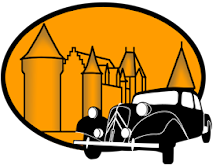Scientific Name: Amanita phalloides (Amanitaceae). Phalloides='phallus shaped', a reference to the shape of the emerging mushroom.
English Name: Deathcap mushroom (Amanita and allies family).
French Name: Amanite phalloïde; Oronge verte (='green Caesar's mushroom'); Calice de la mort (='chalice of death').
5 Key Characters:
- quite large, with a 5 - 15 cm cap; stem 7 - 15 cm high, with swollen base.
- odourless when young, then faintly sweet smelling, unpleasant smelling when old.
- usually has a pale yellowy green or olivey bronze cap, sometimes white, especially when young.
- looks like an egg when young, the cap flattens out as it matures.
- gills white to cream.
Lookalikes: Wood Mushroom Agaricus silvicola and Field Mushroom A. campestris, both edible mushrooms which can be found growing alongside Deathcaps. Young Agaricus spp mushrooms have grey or pinkish brown gills, not white. Young Deathcaps, still at the phallic stage, could be mistaken for edible puffballs such as Common Puffball Lycoperdon perlatum. Always cut puffballs in half vertically if you are intending to eat them. That way if you have misidentified them the inner structure will make it clear. False Deathcap Amanita citrina and Grisette A. vaginata, both locally common (the former in the forest, the latter in more open woodland such as our orchard). Certain edible greenish Russula spp, such as Greasy Green Brittlegill R. heterophylla and Green Cracking Russula R. virescens. The Yellow Knight Tricholoma equestre, until recently a popular edible species in France, now revealed to be poisonous.
Habitat: It is primarily a lowland species, so this area is the heartland of its distribution. Grows on the roots of trees, especially oaks Quercus spp, but also Beech Fagus sylvatica, Sweet Chestnut Castanea sativa, Horse Chestnut Aesculus hippocastanum, Silver Birch Betula pendula, Hazel Corylus avellana, Hornbeam Carpinus betulus, and occasionally Pines Pinus spp and Spruces Picea spp.
Fruiting Period: July-August-September-October-November.
Status: Common. One of the two most deadly and dangerous fungi in the forest.
Edible or Toxic? Responsible for 90% of deaths related to mushroom consumption in Europe. It contains a toxin which damages kidneys and livers, which is not destroyed by cooking, drying or freezing. The initial symptoms are digestive discomfort, with diarrhea, nausea, vomiting and abdominal pains within 5 -12 hours of consumption and lasting for a couple of days. This can lead to dehydration, hypertension, tachycardia and hypoglycemia. Then typically the symptoms fade for several days, only to return once it is too late and irreparable damage has been done to the kidneys and liver. Delerium, fits, coma and death after 6 - 16 days result if treatment is not sought. Early treatment usually involves activated carbon or stomach pumping plus rehydration, later treatment a liver transplant, and is not guaranteed to succeed (10 - 15% of patients still die, especially children). There is no recognised antidote to the toxin. The lethal dose can be as little as half a cap. Many mycologists will advise never eating any Amanita spp, but especially the white ones, as a precaution. Others will go so far as to say do not even touch Deathcaps and do not eat any mushroom which has any possibility of being contaminated by proximity to a Deathcap (eg in the same picking basket). Curiously, some mammals, such as rabbits and squirrels, appear to be able to eat Deathcaps and suffer no ill effects. Slugs can also eat them, but this is less surprising as their digestive systems are very different to ours.
Photographed by Loire Valley Nature:







No comments:
Post a Comment